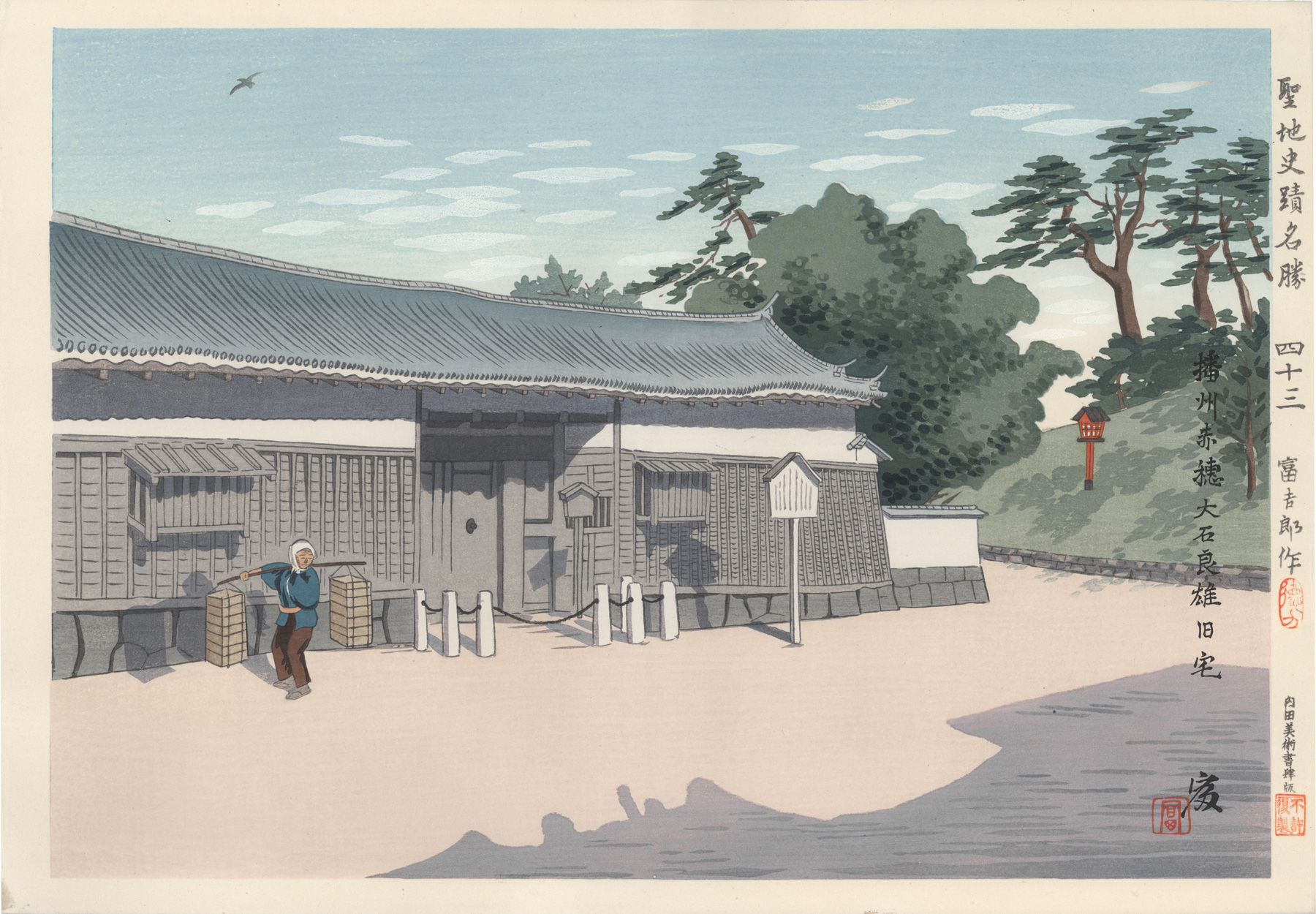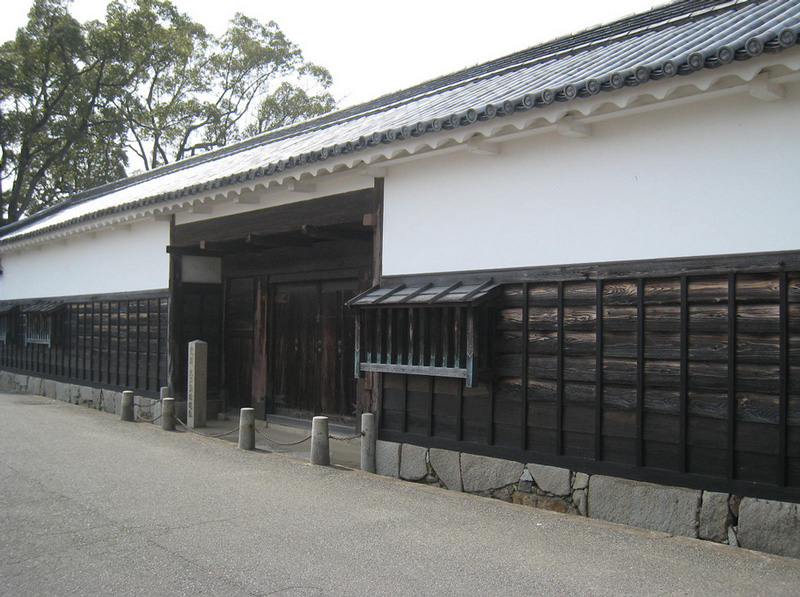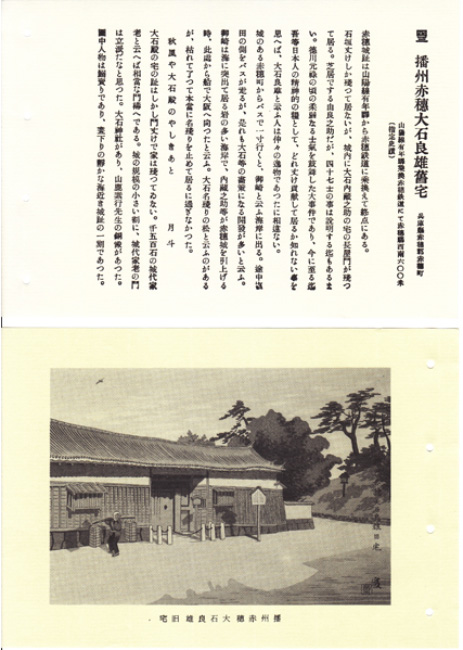About This Print
Print number forty-three of the fifty print series Scenes of Sacred and Historic Places (Seichi Shiseki Meisho) published by Uchida Woodblock Printing Company in 1941, depicting the house of the Ōishi Yoshio, the leader of the Forty-seven Ronin, famous for their determined effort to avenge their lord's disgrace and death.The house of Oishi Yoshio (Kuranosuke), the Akochamberlain who led the secret vendetta of the forty-seven. The gate is said tobe the original one on which the messenger from Edo knocked, bringing the newsof Lord Asano's forced seppuku.
The Story of Ōishi Yoshio and the Forty-seven Ronin
Source: Traveller’s History of Japan, Richard Tames, Interlink Books, 4th edition 2008 , p. 105-107.In 1701 Asano Naganori, lord of the Ako domain in the then Harima province (now part of Hyogo prefecture) was ordered to serve as one of the shogun’s representatives to meet envoys bringing New Year greetings from the emperor to Kyoto. To prepare himself appropriately he was obliged to receive instruction in the correct etiquette from the shogun’s chef d protocol, the greedy and conceited Kira Yoshinaka. Unfortunately Asano (or in some versions his steward) omitted to demonstrate his gratitude in advance by offering Kira a substantial fee/gift/bribe. Kira then behaved so arrogantly towards Asano that the latter, outraged, drew his sword and slashed at his tormentor. The swift intervention of another courtier deflected the blow and Kira escaped with a slight wound. But Asano had already signed his own death-warrant by daring to draw a weapon within the precincts of the shogun’s residence. Asano was condemned to commit seppuku, his estate was confiscated and his entourage of samurai dismissed and cast adrift as ronin (literally ‘wave men’, i.e. having no direction, masterless). Kira went unpunished.
Asano’s chief retainer, Oishi Yoshio, dutifully supervised the hand-over of the estate, hoping that the house might be re-established under Asano’s younger brother. When it became clear that this was not going to happen he plotted vengeance and united forty-six other loyal samurai in a secret blood-oath to pursue the vendetta. Realizing that Kira would take extraordinary precautions against a possible revenge attack the conspirators lay low and waited to throw off suspicion. Oishi himself set an extreme example by hiving himself over to drunkenness and debauchery, enduring the insults of other samurai for his apparent gutlessness.
After two years the ronin judged that Kira believed himself to be safe from retribution and decided to strike. Disguised as a detachment of firemen (so that they could carry ladders without arousing suspicion) the conspirators passed through deserted, snowy streets on the night of 14/15 December 1702 and stormed Kira’s mansion. Dragging him from his hiding-place they beheaded him, took the head to the grave of their master at Sengakuji temple and calmly awaited their fate.
The authorities were faced with a dilemma. The conspirators had showed to the highest degree qualities most admirable in a warrior – loyalty, daring and, not least, dogged determination. Many admired them, from the common people to the shogun himself, and the head of the Hosokawa clan, into whose custody they were placed, treated them as honoured guests and offered to take them on as vassals. On the other hand their action was a clear defiance of the judgment passed upon their lord and, in the view of the shogun’s senior counselors, must be punished.
It was more than a month before a decision was reached. The shogun even took the unusual step of appealing to the abbot of Ueno for his advice but he came down on the side of the death sentence on the grounds that the ronin had achieved a peak of spotless honour and, should they live on, some at least would be bound to tarnish their glory by a lapse of one sort or another. In the end there was a sort of compromise: rather than being executed as common criminals the offenders would be permitted to die like heroes by their own hand. They did so on 4 February 1703. (Only Chikara, Oishi’s son and the youngest of the conspirators, was spared.) They now lie beside their master at Senkaguji in Tokyo’s Minato district.
In 1701 Asano Naganori, lord of the Ako domain in the then Harima province (now part of Hyogo prefecture) was ordered to serve as one of the shogun’s representatives to meet envoys bringing New Year greetings from the emperor to Kyoto. To prepare himself appropriately he was obliged to receive instruction in the correct etiquette from the shogun’s chef d protocol, the greedy and conceited Kira Yoshinaka. Unfortunately Asano (or in some versions his steward) omitted to demonstrate his gratitude in advance by offering Kira a substantial fee/gift/bribe. Kira then behaved so arrogantly towards Asano that the latter, outraged, drew his sword and slashed at his tormentor. The swift intervention of another courtier deflected the blow and Kira escaped with a slight wound. But Asano had already signed his own death-warrant by daring to draw a weapon within the precincts of the shogun’s residence. Asano was condemned to commit seppuku, his estate was confiscated and his entourage of samurai dismissed and cast adrift as ronin (literally ‘wave men’, i.e. having no direction, masterless). Kira went unpunished. Asano’s chief retainer, Oishi Yoshio, dutifully supervised the hand-over of the estate, hoping that the house might be re-established under Asano’s younger brother. When it became clear that this was not going to happen he plotted vengeance and united forty-six other loyal samurai in a secret blood-oath to pursue the vendetta. Realizing that Kira would take extraordinary precautions against a possible revenge attack the conspirators lay low and waited to throw off suspicion. Oishi himself set an extreme example by hiving himself over to drunkenness and debauchery, enduring the insults of other samurai for his apparent gutlessness. After two years the ronin judged that Kira believed himself to be safe from retribution and decided to strike. Disguised as a detachment of firemen (so that they could carry ladders without arousing suspicion) the conspirators passed through deserted, snowy streets on the night of 14/15 December 1702 and stormed Kira’s mansion. Dragging him from his hiding-place they beheaded him, took the head to the grave of their master at Sengakuji temple and calmly awaited their fate. The authorities were faced with a dilemma. The conspirators had showed to the highest degree qualities most admirable in a warrior – loyalty, daring and, not least, dogged determination. Many admired them, from the common people to the shogun himself, and the head of the Hosokawa clan, into whose custody they were placed, treated them as honoured guests and offered to take them on as vassals. On the other hand their action was a clear defiance of the judgment passed upon their lord and, in the view of the shogun’s senior counselors, must be punished. It was more than a month before a decision was reached. The shogun even took the unusual step of appealing to the abbot of Ueno for his advice but he came down on the side of the death sentence on the grounds that the ronin had achieved a peak of spotless honour and, should they live on, some at least would be bound to tarnish their glory by a lapse of one sort or another. In the end there was a sort of compromise: rather than being executed as common criminals the offenders would be permitted to die like heroes by their own hand. They did so on 4 February 1703. (Only Chikara, Oishi’s son and the youngest of the conspirators, was spared.) They now lie beside their master at Senkaguji in Tokyo’s Minato district. |
To read more about the representations of Chūshingura in woodblock prints see the article on this site Chūshingura (The Treasury of Loyal Retainers) in Woodblock Prints.
The Series - Scenes of Sacred and Historic Places
The print artist Tokuriki and the publisher Unsōdō created two series of prints to mark Kigen 2600, or the 2600th year of Japan's mythical founding as a nation. The first, a paean to Mount Fuji, a sacred site of pilgrimage and worship, titled Thirty-Six Views of Mount Fuji, harkened back to Hokusai’s famous 1831 series of the same name. The second series, Scenes of Sacred and Historic Places, capitalized on the nationalist ideology that Japan was a divine land, presenting overtly nationalistic landscapes including shrines, temples, castles, places associated with the divine origins of Japan, Meiji era history and samurai
culture.
In his commentary on this series, the artist wrote that his devotion to these sites is intended to demonstrate to the people the dignity of the national polity, going on to say that he advocates prints as a means of providing comfort and pleasure to the wholesome citizens of the nation.
This series was extremely popular with domestic and foreign buyers who purchased one thousand copies within a short time after issuance.1 I imagine that foreign buyers were enchanted by the lovely scenes with much of the import of each print escaping them. In the 1950s, six prints from this series were re-printed under the title The Album of Famous Views of Japan and eight additional prints were re-printed under the title The Eight Views of Japan. Later printings omit the information in the margin and some position the artist's signature and print title within the image in a different location from the original issue.
For images of all the prints in the series, go to the website of Ross Walker's Ohmi Gallery at http://www.ohmigallery.com/Gallery/Tokuriki/SacredPlaces.htm.
1 Modern Japanese Woodblock Prints - The Early Years, Helen Merritt, University of Hawaii Press, 1998, p. 89.
In his commentary on this series, the artist wrote that his devotion to these sites is intended to demonstrate to the people the dignity of the national polity, going on to say that he advocates prints as a means of providing comfort and pleasure to the wholesome citizens of the nation.
For images of all the prints in the series, go to the website of Ross Walker's Ohmi Gallery at http://www.ohmigallery.com/Gallery/Tokuriki/SacredPlaces.htm.
1 Modern Japanese Woodblock Prints - The Early Years, Helen Merritt, University of Hawaii Press, 1998, p. 89.
Margin Annotations of Original Edition (top to bottom) and Print Title Within Image
 series title Seichi Shiseki Meisho 聖地 史蹟 名勝 |  四十三 (43) |  Tomikichiro kin saku 富吉郎 謹作 (respectfully made by Tomikichiro) followed by oval seal1 |  内田美術書肆版 (Uchida Fine Art Shop) followed in seal form by Fukyo Fukusei (Reproduction forbidden)) | Print Title  播州赤穂大石良雄旧宅 (Banshū-Akō Ōishi Yoshio kyūtaku) |
1 possibly a reproduction of an old censor's seal
The title of each print appears within the image area along with the artist's signature and seal. The artist's signature is generally comprised of the artist's name 富吉郎 (Tomikichirō) or a part of the artist's name, e.g. 富. either by itself or followed by the single kanji character 作 (saku "made by") or by the character 謹 (kin "respectfully") followed by 作.
| IHL Catalog | #1101 |
| Title | Former Residence of Ōishi Yoshio in Banshū-Akō 播州赤穂大石良雄旧宅 Banshū-Akō Ōishi Yoshio kyūtaku |
| Series | Scenes of Sacred and Historic Places (also seen translated as "Collected Prints of Sacred, Historic and Scenic Places") 聖地 史蹟 名勝 Seichi Shiseki Meisho |
| Artist | Tokuriki Tomikichirō (1902-2000) |
| Signature |  |
| Seal | Tomi 富 (as shown above) |
| Date | September 1941 |
| Edition | original (first) edition |
| Publisher | Uchida Bijutsu Shoten |
| Impression | excellent |
| Colors | excellent |
| Condition | excellent - slight toning |
| Genre | shin hanga (new print); fūkeiga |
| Miscellaneous | 四十三 #43 in series |
| Format | horizontal oban |
| H x W Paper | 11 1/4 x 16 1/4 in. (28.6 x 41.3 cm) |
| H x W Image | 10 3/8 x 15 (26.4 x 38.1 cm) |
| Collections This Print | Penn Libraries, Rare Book & Manuscript Library - Rare Book Collection Call no.: Portfolio NE1325.T65 A4 1940 |
| Reference Literature |




